
Figure 1. Asian Common Toad (Source: Wikimedia . Photo taken by Lokionly. Creative Commons Attribution-Share Alike 3.0 Unported license)
1. INTRODUCTION
Table of Contents
The Asian Common Toad (Duttaphrynus melanostictus) is the most common and well known native terrestrial amphibian in Singapore. They are so abundant and widespread (not just in Singapore but also across Asia) that you can find it across habitats ranging widely from forest margins, ponds and even in your own neighborhood. You might just catch a glimpse of it at night or after heavy rain, congregating under your street lamps to feed on the unsuspecting insects attracted to the light [1]. Although the Asian Common Toad may appear to be aesthetically unappealing due to its many warts and dry skin, a closer look reveals interesting details mentioned in this species page.
Video 1. The call of the Asian Common Toad that can often be heard at night or after rain near grass lawns or under street lamps. (Source: Youtube by Leong Tzi Ming.)
The Asian Common Toad was originally part of the large typical toad genus Bufo as Bufo melanstictus but as of 2006 has then been moved to a separate genus Duttaphrynus as D. melanostictus [2]. However, most available field guides may still list the Asian Common Toad as B. melanostictus. It is worth noting that whichever name you come across, both names still refer to the same species. The information you would find in this species page identifies the Asian Common Toad by its more updated name; D. melanostictus.
This species page particularly aims to provide a broad range of information regarding the Asian Common Toad from a general description of its morphology, interesting behaviors, associations with humans and taxonomic details. The different page sections would appeal towards different visitors to this page:
| If you happen to see a croaking lump and you are wondering what it is you just saw: |
|
| If you are an undergraduate or student: |
|
| If you are a conservationist: |
|
| If you are interested in the species’ phylogeny and taxonomic status: |
|
| If you are really interested to learn more about the Asian Common Toad: |
|
2. TOADS VS FROGS
“Are frogs and toads not the same?” might just be the first question that would most likely pop up in your head upon reading this section. Although both amphibians do belong to the same order Anura, toads are actually a subset of frogs and belong to the families Bufonidae, Bombinatoridae, Discoglossidae, Pelobatidae, Rhinophrynidae, Scaphiopodidae, and Microhylidae. They differ mostly in their genetic sequences and skeletal structure but can also generally be distinguished by the distinct physical and behavioral characteristics (Figure 2):
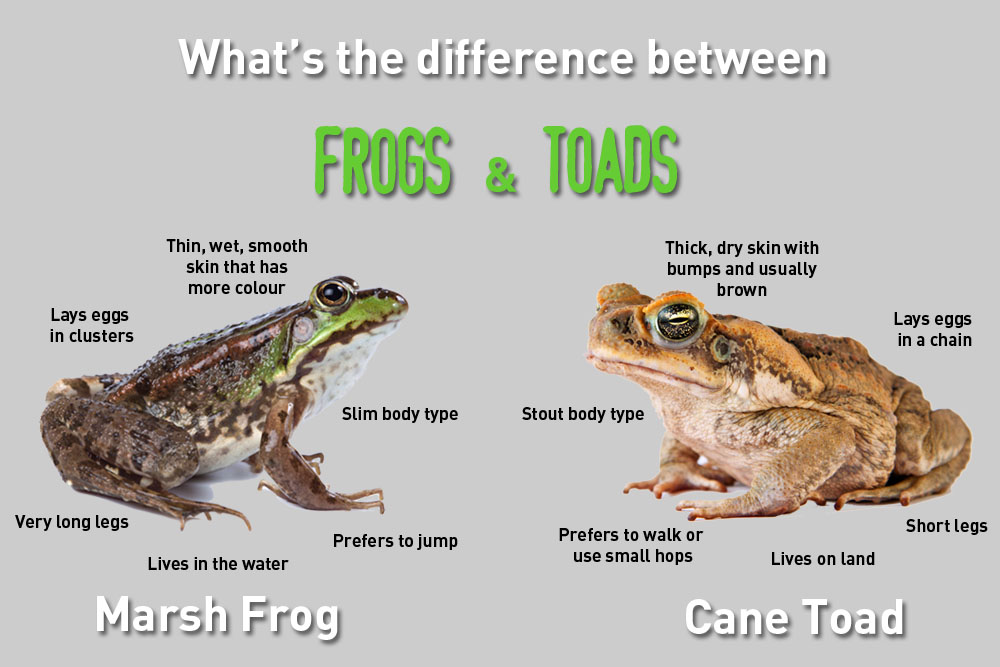
Figure 2. Morphological differences to distinguish between frogs (e.g. Marsh frog) and toads (e.g. Cane toad). (Source: The Earth Rangers Foundation. Adapted from Dorcas & Whitifield Gibbons, 2008. Permission granted by The Earth Rangers Foundation.)
Despite these physical differences, it is important to note that it is common to find toads that look like frogs and frogs that look like toads. These physical characteristics (figure 2) used to categorize a species into either a toad or a frog are merely generalizations of common characteristics. Therefore, it is not wise to deem an amphibian a toad simply based on how it looks. Instead, genetic sequences and skeletal structures provide a slightly more accurate classification. Luckily, the Asian Common Toad bears the characteristics of a general toad with its dry and warty skin, stumped body, short legs and inability to jump very high.
3. MORPHOLOGY
3.1 Identification
The Asian Common Toad that you might come across may be at different stages of its life history; be it at their adult stage or juvenile stage. Thus, the following are distinctive features can be accounted for when trying to identify the Asian Common Toad at its different life stages (Adult, Juvenile and Tadpole):
ADULT
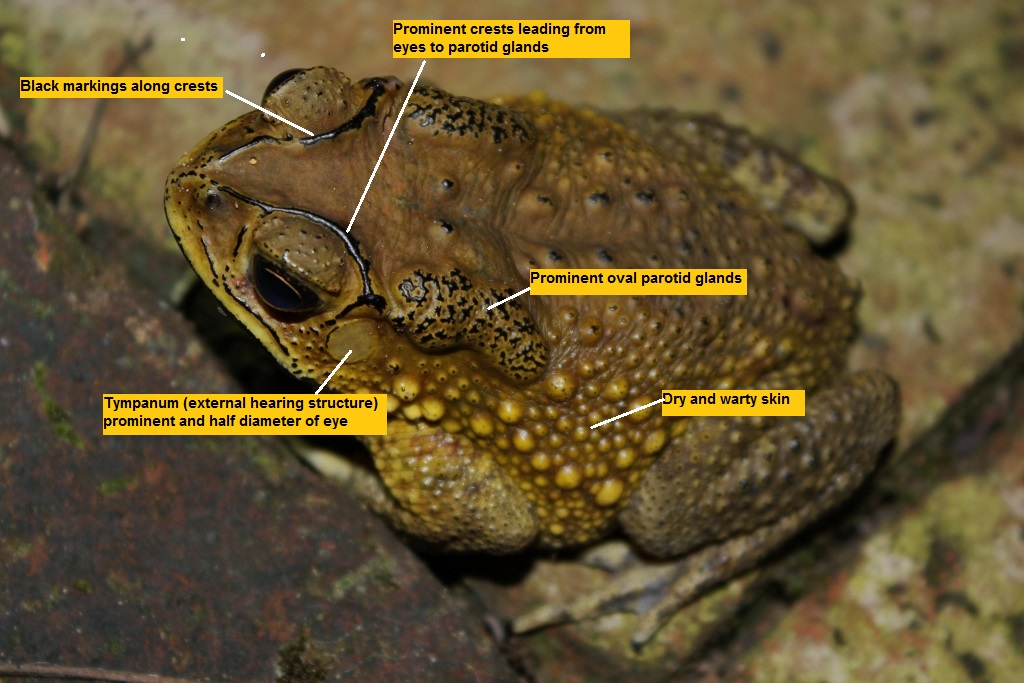
Figure 3. Distinctive features of an Asian Common Toad. (Source: Flickr. Photo taken by Thomas Brown. Adapted notes by Siti Maimon Hussin. Creative Commons Attribution-Share Alike 3.0 Unported license)
These distinctive and highly prominent features greatly helps distinguish the Asian Common Toad from other similar looking toads. These features highlighted in Figure 3 are enough to aid identification if you are a novice explorer or manage to only catch a quick glimpse of this nocturnal amphibians. However, there are also other morphological features (Figure 4) that may not be as prominent but can be just as helpful if you manage to capture or come close enough to the Asian Common Toad.
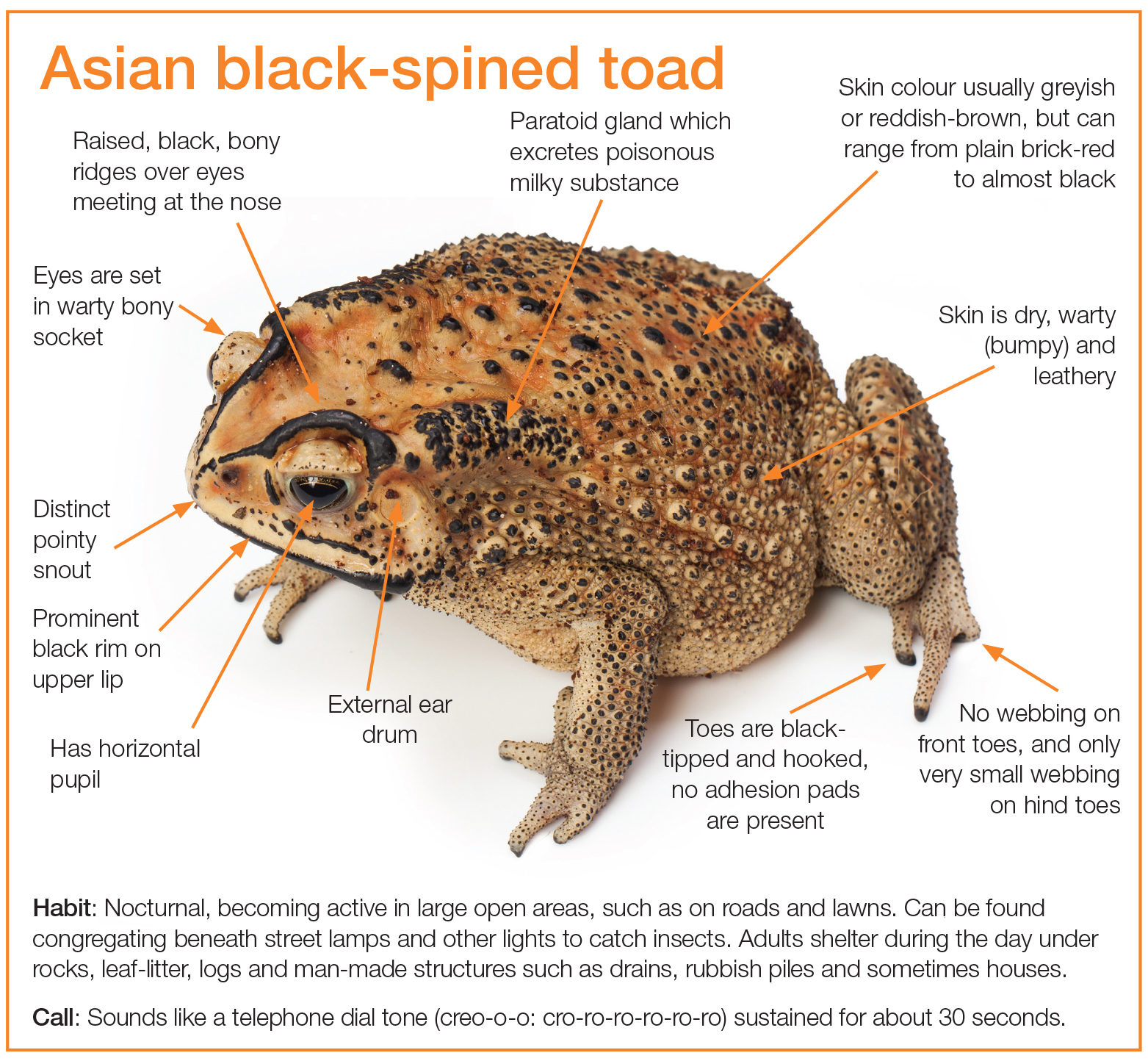
Figure 4. Detailed features, habitat and call of the Asian Common Toad for identification. The Asian Black Spined Toad is another common name used for the Asian Common Toad (Source: Victoria State Government. Permission for usage still pending.)
Table 1. Detailed description of the morphology of the Asian Common Toad in its adult stage to aid in identification.
| Color |
|
| Head |
|
| Eyelids |
|
| Skin |
|
| Snout |
|
| Tympanum (external hearing structure) |
|
| Parotid gland |
|
| Hindlimbs |
|
| Fingers |
|
| Toes |
|
JUVENILES
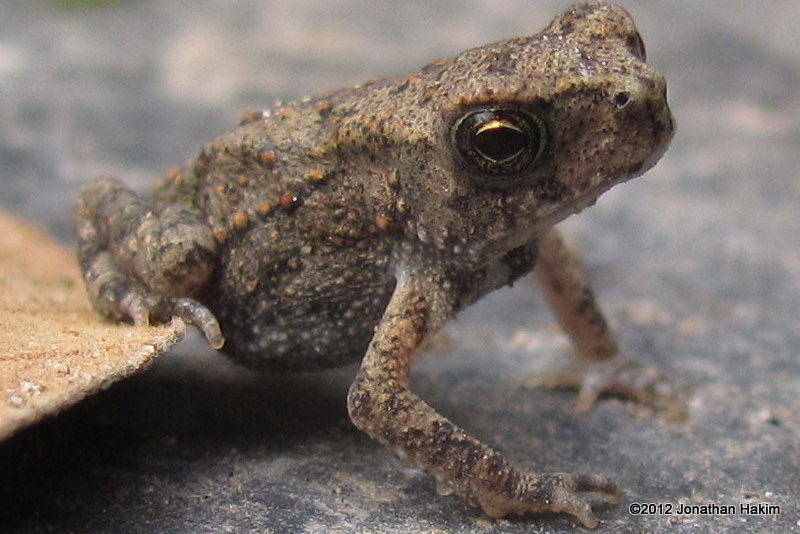
Figure 5. Juvenile of Asian Common Toad from Bangkok (Source: Reptiles and Amphibians of Bangkok. Photo taken by Jonathan Hakim. Creative Commons Attribution-Non Commercial-Share Alike 3.0 Unported)
There are slight differences between juvenile Asian Common Toads to their adult counterparts. Juveniles possess a black band around their throat that runs between the chin and the breast. Juveniles also do not have the distinct warts seen in adults. Their tympanum (external hearing structure) is much smaller than the adults.
The differences in morphology between the juveniles and adults makes identification of the Asian Common Toad difficult if we only characterize them by their morphology. Instead, looking at their genetic sequences (which is the same as the adult!) is more helpful in identification.
TADPOLES
Figure 6. Tadpole stage of Asian Common Toad from Hong Kong (Source: The University of Hong Kong School of Biological Sciences. Photo taken by Teresa Ma.)
Tadpoles are often found in groups at slow and still moving water such as the side pools along hilly torrents, marginal waters of ponds and puddles. They can be characterized by the following details [3]:
Table 2. Description of the Asian Common Toad at its tadpole stage
| Size |
|
| Color |
|
| Shape |
|
| Beak |
|
| Fin |
|
| Tail |
|
Interested to learn more about the tadpoles of Asian Common Toad, then jump straight to: Life history: Growth and metamorphosis for further information regarding this fascinating stage in the Asian Common Toad’s life history.
3.2 Determining gender
After successfully identifying the Asian Common Toad, it is also possible to determine its gender based on the few distinct differences in morphological features mentioned below [4]:
Table 3. Detailed differences in morphology between male and female Asian Common Toad at its adult stage
| Morphology |
Male |
Female |
| Size (From snout to vent) |
57 – 83 mm |
65 – 85 mm |
| Subgular vocal sac |
Black pigmented subgular vocal sac which opens into the pharynx by a single asymmetrically located slit. |
Absent |
| Throat region |
Dull copper yellow/ bright yellow orange throat region |
Light gray or gray buff |
| Fingers |
Inner side of first and second fingers have pale grey to intense black nuptial pads |
Absent |
| Bidder’s organ |
Remains throughout life in males |
Has a tendency to disappear in majority of females after maturity |
4. DISTRIBUTION
4.1 Global distribution
The Asian Common Toads have a wide distribution across Asia. The native distribution extends north Pakistan through Nepal, Bangladesh, India, Sri Lanka, Southern China, Myanmar, Lao, Vietnam, Thailand, Cambodia, Malaysia, Singapore, and Indonesia (Sumatra, Java, Borneo and Natuna Islands).
They were introduced to the islands of Bali, Sulawesi, Ambon and Manokwari, and the northeastern portion of the Vogelkop Peninsula in New Guinea [5]
Figure 7. Global distribution of Asian Common Toad (Green placemarkers - Native; Red placemarkers - Naturalized or Invasive)
4.2 Local distribution
In Singapore itself, the Asian Common Toad has been recorded in various parks in Singapore such as West Coast Park, Chinese Garden, Singapore Botanic Gardens, East Coast Park, Pasir Ris Park, Sungei Wetland Nature Reserve, MacRitchie Resevoir and even Pulau Ubin (Figure 8).
Figure 8. Distribution of the Asian Common Toad in Singapore. (Source: The DNA of Singapore, RMBR)
4.3 Habitat
The Asian Common Toads are generalists. They can be found in a widespread range of habitats such as in our urban areas, under ground cover (e.g. rocks, leaf litter and logs), in human dominated agricultural land, in water bodies like upper beaches, riverbanks, ponds and lakes, and in disturbed lowland forests and edges of these forest. As it is a nocturnal amphibian, it can be found in open areas at night to feed on insects but later hides under rocks, leaf litter and man-made structures for shelter during the day. It can also be found in more aquatic biomes as the Asian Common Toad breeds particularly in still and slow-moving waterbodies, rivers, ponds and pools [6].

Figure 9. This Asian Common Toad from Singapore is a common sight particularly at night or after a heavy rain (Source: Wildlife Singapore. Photo by Nick Baker and Kelvin Lim)
In Singapore, this very common Asian Common Toad can be found among vegetation, roads and jungle paths, and in bodies of water throughout Singapore. Its commonality in Singapore is not simply just due to its wide range of habitat but also due to its availability throughout the year, regardless of dry or wet conditions [7].
5. BIOLOGY
5.1 Toxicity
True toads are defined by the parotid glands behind their eyes that secrete powerful toxins that can be deadly to their enemies. No doubt the Asian Common Toads also share this distinctive feature that has been beneficial in deterring many predators. This has allowed the Asian Common Toad to successfully breed without a fear of predation. Their oval or elliptical parotid glands secretes a milky and pungent substance (called Bufotoxin) that have been recorded to be fairly toxic. On top of that, their skin also excretes several bioactive compounds with lethal, hypotensive, hypertensive, neurotoxic, cardiotoxic, haemolytic and sleep inducing factors [8]. The toxin from the parotid glands and secretions from the skin of the Asian Common Toad has driven countless of scientific studies on discovering and further understanding these interesting properties for possible drug discovery against cancer.
There has been records of the Asian Common Toad causing skin irritations, illnesses and even deaths to humans particularly in Laos and Taiwan where these toxic toads were consumed [9] [10]. Yikes! Seems like the best option is to stay away from the Asian Common Toad. However, there is no need to be too alarmed as its toxicity level (only when physically touched) is relatively too low to be directly life threatening to humans [11]. Only consumption of the Asian Common Toad has shown adverse health effects.
Physical handling of the Asian Common Toad is still relatively safe for humans. However, it is still advisable to practice good hygiene after handling them.
5.2 Adaptations to urban landscape
The urban landscape can be particularly challenging for some wildlife species. However, the ability for a species to successfully adjust and adapt to the urban environment and its harsh anthropogenic pressures demonstrates the specie's fascinating ecological and behavioral plasticity [12]. For the Asian Common Toad, it has been extremely successful in adapting to the urban Singapore landscape as observed by its great abundance even in grassy lawns and drains [13].

Figure 10. Dry, thick and relatively impermeable skin of the Asian Common Toad allows it to tolerate the drier and harsher urban conditions (Photo taken by Shyamal, L.
Creative Commons Attribution-Share Alike 3.0 Unported license)
This feature of being highly adaptable and tolerant to disturbance and severe habitat alteration is due to its thick and relatively impermeable skin. Their skin allows the Asian Common Toad to be less susceptible to drying and helps increase its ability to survive even in dry urban microhabitats [14].
Its toxic skin secretion and parotid gland are poisonous to predators and enemies from the urban environment. This has given the Asian Common Toad the added advantage to expand its population number without facing the risk of predation. Even during its tadpole stage, the Asian Common Toad has been recorded to be toxic thus reducing predation risks. The tadpoles are also noted to be capable of assessing predatory risk and reducing its time in feeding and delaying metamorphosis to avoid predators [14]. Studies have shown that tadpoles reared with a predator that fed on other tadpole species were able to develop these capabilities (assess predatory risk; reduce feeding time; delay metamorphosis) compared to tadpoles that were grown in a predator-free environment. These abilities allow the Asian Common Toad to thrive even better in the urban landscape.
The Asian Common Toads are also great generalists in their habitats and feeding habits. Their ability to thrive in a range of habitats and feed on a variety of food allows the Asian Common Toad to survive and reproduce better than other species that has a narrower environmental tolerance and lower resilience to the urban landscape.
5.3 Diet
Video 2. Asian Common Toad feeding on winged termites (Source: Youtube. From Wild Angles.)
The Asian Common Toads are mostly insectivorous that feed on wasps, bees and ants but are also known to be opportunist that can also feed on a variety of arthropods and mollusks. Arthropods such as earwigs, grasshoppers, crickets, true bugs, moths and butterflies, beetles, typical bugs, termites, cockroaches, mantids, true flies, centipedes and millipedes have also been recorded in the stomach of some Asian Common Toads [10] [11]. This opportunistic feeding is particularly observed by some Asian Common Toads from the Singapore Botanic Gardens. They were found to feed dominantly on the ants and termites, along with centipedes, millipedes and beetles. Ants and termites are the typical litter fauna found in the grass areas and secondary forest of the Singapore Botanic Gardens [15].
6. LIFE CYCLE
6.1 Life history
Table 4. Summary of the time length during the different life stages of the Asian Common Toad
| Life stage |
Time length |
| Breeding season |
Breed during wet season (In geographic areas with distinct wet and dry seasons) Throughout the year (In Singapore) |
| Call |
Heard throughout the year (In Singapore) |
| Oviposition frequency |
Can possibly breed twice per year |
| Average number of offspring |
40, 000 eggs per clutch |
| Hatching of eggs |
24 – 48 hours |
| Tadpole stage |
34 – 90 days |
| Metamorphosis |
25 – 30 days |
| Life expectancy |
4 years (wild) 10 years (captivity) |
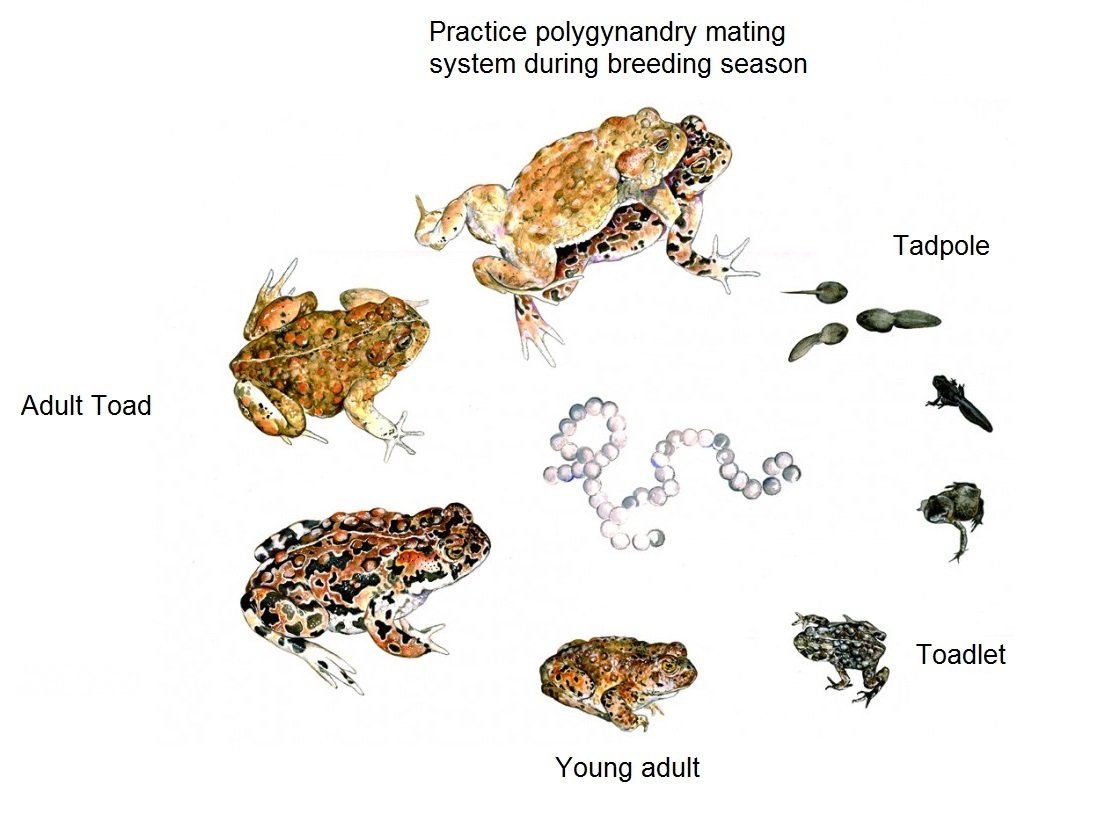
Figure 11. Life cycle of toad (Source: National Geographic Society. Drawing courtesy of Jane Kim. Adapted notes from Siti Maimon Hussin)
6.2 Breeding season
Breeding of the Asian Common Toad has been observed to be dependent on rainfall. In areas outside of Singapore where there are distinct differences in rainfall and temperature during the wet and dry seasons (e.g India, Pakistan and China), breeding occurs more prominently during the wetter seasons. However, Singapore’s high rainfall and temperature throughout the year encourages the Asian Common Toad to persist breeding all year round [7].
This is further supported by the observation of mature sex characteristics in both males and females throughout the year in Singapore. Mature adult males in Singapore were observed to have nuptial pads and comparable secondary sexual characters while its female counterparts were found to have enlarged oviducts in all months. Male Asian Common Toads are also noted to have a continuous spermatogenic cycle whereby sperm cells are produced year round [18]. These ‘reproductive ripeness’ indicates the readiness of the Asian Common Toad to breed throughout the year. The male Asian Common Toad were also observed to have enlarged vocal sacs in most months. This feature is important for males to vocalize their calls to attract potential mates throughout the year [7].
6.3 Call
Video 3. Call of Asian Common Toad in Singapore by Leong Tzi Ming. (Source: Youtube)
The call of the male Asian Common Toads has been noted to sound like “curr-curr-curr”. The Asian Common Toad are not recorded to make any other vocalizations except for the calls (Video 3) observed only during mating. [10]. Calls were heard throughout the year in Singapore indicating all year round breeding [7].
6.4 Mating

Figure 12. A mating male (on top and smaller in size) and a female (below and larger in size) Asian Common Toad in the standard amplexus mating position. (Source: Flickr. Photo taken by Thomas Brown. Creative Commons Attribution-Share Alike 3.0 Unported license.)
Asian Common Toads can breed opportunistically in small natural and man-made water bodies including gutters, puddles, and cement cisterns in parks. Males would congregate at these breeding sites and call to attract the females [10][11]. These calling males can become quite aggressive as they tug and jump over each other to secure a nuptial hold on the females. As males often largely exceed females in their numbers, the Asian Common Toad practices polygynandry mating system. This is typically observed in large populations such as the Asian Common Toad. The male and female then shakes off other suitors and move to a quieter place away from the breeding site to mate [19].
6.5 Reproduction
The female will lay a long string of black eggs in generally deep and quiet waters or pools, which are then externally fertilized by the male. Eggs are enclosed in a thick mucus membrane and deposited on submerged vegetation [20]. Average number of 40, 000 eggs per clutch were observed.
6.6 Growth & Metamorphosis
Asian common toads have a typical Anuran development which is indirect with an aquatic tadpole stage. Tadpoles then hatch form their eggs within 24 and 48 hours, depending on the water conditions. Increase in reproductive success of the tadpoles of the Asian Common Toad were sometimes observed during their tadpole stage. This reproductive success has been studied to be partly dependent on kinship and evasion from predators.
Tadpoles that were reared with their sibling groups grew at a higher rate and developed faster compared to those that were reared in mixed groups [19]. The high number of eggs produced by the females results in intra-specific competition among tadpoles. These tadpoles also showed the ability to evade predators by emerging at different times and sizes in the presence of predators. A decrease in body mass of up to 46% and a delayed metamorphosis are also behaviors that the Asian Common Toad tadpole has adapted against predators allowing successful growth of the Asian Common Toad species to huge population numbers [21].
The tadpoles then undergo metamorphosis to become a toadlet where they start to lose their tail and become less dependent on the aquatic environment. Metamorphosis to the toadlet stage can take up 25 - 30 days.
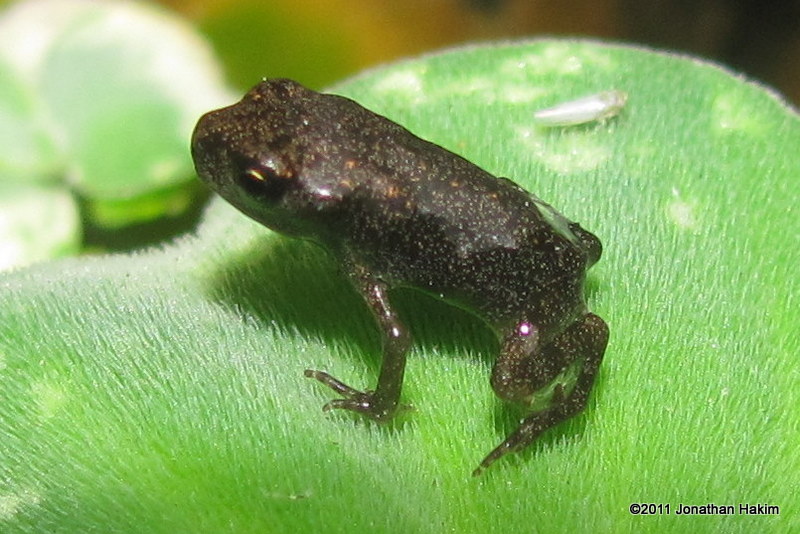
Figure 13. Metamorphosed toadlet of Asian Common Toad that usually takes up 25 – 30 days but can be delayed upon presence of predators (Source: Reptiles and Amphibians of Bangkok. Photo taken by Jonathan Hakim. Creative Commons Attribution-Non Commercial-Share Alike 3.0 Unported)
7. CONSERVATION
7.1 Singapore
The Asian common toads are listed on the International Union for Conservation of Nature (IUCN) Red list as “Least Concern”. Their high reproductive success, adaptability to the urban environment and widespread distribution allows the Asian Common Toad to have a high population in Singapore [6].
7.2 Outside of Singapore
In the regions of the world that these toads have become naturalized, populations are on the rise. These toads are becoming increasingly common and a cause of concern [1][7][11]. The Asian Common Toad is regarded as a significant invasive pest in Queensland, Australia and is predicted to possibly overtake Australia's infamous native pest, the Cane Toad (Rhinella marina). Similar to Cane toads, the Asian Common Toad has been reviewed to be a threat to the native Anuran and invertebrate communities in Australia through predation and competition for food and shelter. They have the potential to carry exotic parasites and diseases that can cause severe impacts to the native population [25].
The Asian Common Toad was also first detected in Bali in 1958 which then spread throughout Indonesia to Papua New Guinea. Their ecological impact in Papua remains unknown due to lack of assessment and study. They were also observed recently in East Timor and are suspected to cause serious ecological problems, comparable to the impact of Cane Toads in Australia. To date, no quantitative assessment has been carried out to measure their impacts in East Timor [11].
8. TAXONOMY
8.1 Taxonavigation
- Animalia (kingdom)
- Chordata (phylum)
- Tetrapoda (superclass)
- Amphibia (class)
- Anura (order)
- Bufonidae (family)
- Duttaphrynus (genus)
- Duttaphrynus melanostictus (species)
- Duttaphrynus (genus)
- Bufonidae (family)
- Anura (order)
- Amphibia (class)
- Tetrapoda (superclass)
- Chordata (phylum)
The Asian Common Toad was previously placed in the genus Bufo as Bufo melanostictus by Schneider in 1799 [10]. However, its taxonomic hierarchy has recently been revised in 2006 under the genus Duttaphrynus as Duttaphrynus melanostictus by Frost as he concluded that Duttaphryunus is only distantly related to other Asiatic bufonids [2].
8.2 Synonyms
- Bufo melanostictus (Schneider, 1799)
- Bufo chlorogaster Daudin, 1802
- Rana dubia Shaw, 1802
- Bufo scaber Daudin, 1802
- Bufo bengalensis Daudin, 1802
- Bufo flaviventris Daudin, 1802
- Bufo carinatus Gray, 1833
- Bufo isos Lesson, 1834
- Bufo gymnauchen Bleeker, 1858
- Docidophryne isos Fitzinger, 1861
- Docidophryne spinipes Fitzinger, 1861
- Phrynoidis melanostictus Cope, 1862
- Bufo spinipes Steindachner, 1867
- Bufo longecristatus Werner, 1903
- Bufo tienhoensis Bourret, 1937
- Docidophryne melanostictus Bourret, 1942
- Bufo camortensis Mansukhani and Sarkar, 1980
- Ansonia kamblei Ravichandran and Pillai, 1990
- Bufo melanostictus melanostictus Khan, 2001
- Bufo melanostictus hazarensis Khan, 2015
(Source: NCBI)
Synonyms tend to arise whenever an existing taxa is changed or moved to a different genus. This is observed by the original name of the Asian Common Toad, Bufo melanostictus being a synonym after Frost, et. al. (2006) transferred it to the genus Duttaphrynus. Synonyms can also arise when the same species is described and named more than once. This error in nomenclature can possibly occur due to:
- Lack of highly connected and updated databases in the past,
- Subjectivity in morphology (e.g. cane toads look almost similar to the Asian Common Toad with the only difference being its smaller size),
- Lack of accurate morphological detail of the holotype noted by Schneider (1799) allows variations (vary mostly in morphology) of the Asian Common Toad to be deemed as a different species instead of one species.
8.3 Common Names
- Asian spined toad
- Southeast Asian toad
- Asian common toad
- Spectacled toad
- Common Indian toad
- Black-spined toad
- Common Sunda toad
- Black-lipped toad
- Keeled-nosed toad
- South Asian garden toad
- Black-spectacled toad
- House toad
- Asiatic toad
- Asian eyebrowridge toad
- Asian black-spotted toad
- Javanese toad.
(Source: EOL)
8.4 Original description
Figure 14. Original description of the Asian Common Toad as described by Schneider in 1799. Asian Common Toad was filed under the section x. Melanotietus in the original description. (Source: Schneider, 1799)
The original description of the Asian Common Toad was by Schneider in 1799 (Figure 14) who filed the species under the name Bufo melanostictus. Certain details regarding his description is summarized as followed (words that could not be translated by Google Translate remain in its original latin form and is italicized):
"Warts top dorfiet joints of body gray color, atropunetatae, limbus side of the head jaw fuperioris black, plants femipalmatae, the tips of the fingers black.
From 'India orientali' Museum Blochianum, gray color, warts capital, artuumque denfae, most planiusculae, black dot, er against both sides of colors, gray, the distance between the eyes depreffum, smooth, exftantis orbital margins, edging back toward the black tympanum until it runs out, antrorfum defeendens on both sides of the nose coit. Idom is surrounded by a fringe cheek fuperiorem, Likewise tips of the fingers and palm calluses two black plantarumque.
Another example of the Mufei, where under his name Chinenfis bufunis proftabat color fundum had to fufeum more inclining, Derfor tiny black spots and unaffected." (translated using Google translate)
Schneider's original description lacks accurate morphological details needed to properly determine the Asian Common Toad. This can pose potential problems in identification from other similar looking cryptic species.
8.5 Type series
Having both the original description and the physical specimen (or an illustration of the specimen) of the species when it was being described provides useful information and details for other taxonomists and users to identify the Asian Common Toad. The following are the type specimens that has been used to construct the morphological details used for the identification of the Asian Common Toad. Unfortunately, for unknown reasons, there is no information accessible regarding the holotype of the Asian Common Toad. Thus, other type series used are listed instead:
Table 5. Type series of the Asian Common Toad and important details (i.e location found, location of storage, etc.) regarding the type.
| Type |
Image |
Details |
| Holotype |
Not available |
Not available |
| Syntypes ZMB 3462-63 |
Not available |
In the Museum für Naturkunde, Universität Humboldt, in Berlin, Germany. The type locality was listed from “India orientali”. |
| Lectotype ZMB 3462 (Note: Lectotypes have no 'legal' standing and so they are often not listed) |
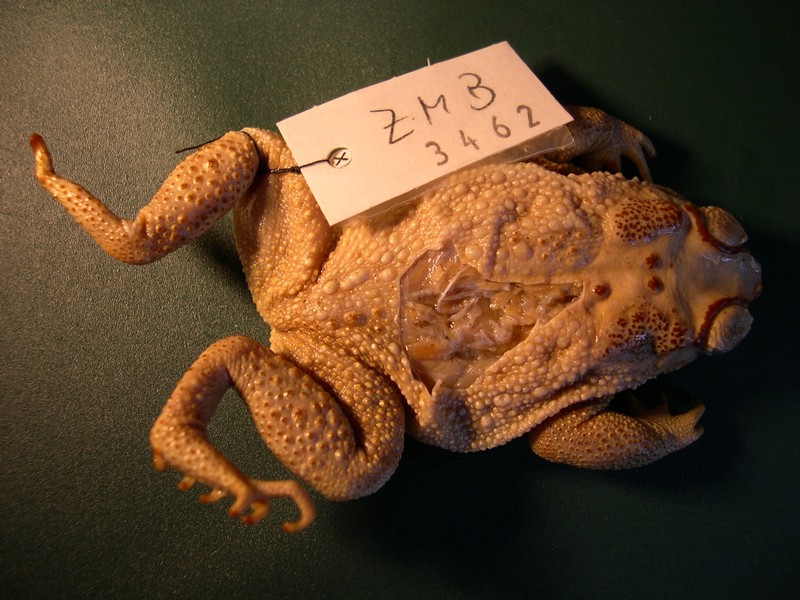 |
Re-described by Dubois & Ohler in 1999 is found in the Museum für Naturkunde, Universität Humboldt, in Berlin, Germany. The type locality was listed from “India orientali” |
| Paratype ZMB 3463 (Note: Paratypes have no 'legal' standing and so they are often not listed) |
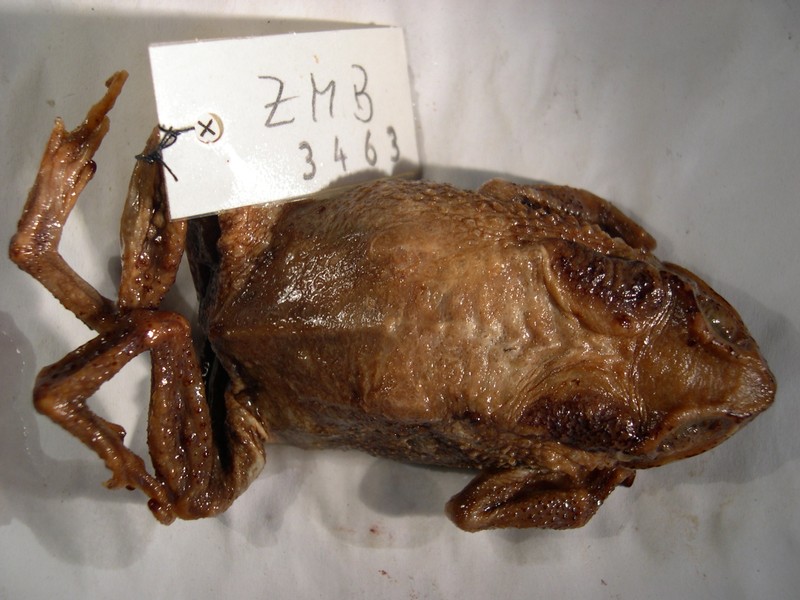 |
Described by Bloch and is found in the Museum für Naturkunde, in Berlin, Germany. The type locality was listed to be from India. |
9. PHYLOGENY
9.1 Gene Sequence
As scientific knowledge and technology continue to advance, we are able to better identify species based not just entirely on morphological differences (which can be relatively incomplete or subjective) but also based on their molecular data (e.g. DNA, nucleotide sequences, protein sequences) and phylogenetic information. These additional details are of great help when identifying the Asian Common Toad from other morphologically similar looking species. The following is the complete genomic sequence of the Asian Common Toad which can be used for identification:
Bufo melanostictus, mitochondrion, complete genome
Accession: Locus AY458592.1
Base pair length: 17374 bp
Table 6. Genomic sequence of the Asian Common Toad (Source: Gen Bank AY458592.1)
1 GCTTTTAAAA GAAAACAGTC TTCTCCTGGT CTTAGGCTCC AGTACCTCTT GGTGCAACTC
61 CAAGTAAAAG CTGCCTCAGT AGCTTAATAC TAAAAGCATT GGTCTTGTAA ACCAAAGAAT
121 GAAGAATAAA CCCTTCCTGA AGCTCAGAAC AGAGAGAATT TAACTCCCAC AGCTAACCCC
181 CAAAGCTAGC ATTCTATTTA AATTATGTCC TGTTTAGATA GCTTATATAA AGCATAGCAC
241 TGAAAATGCT AAGATGGACC CTAAAAAGTC CTTTAAACAC AAAGGTTTGG TCCTGACCTT
301 GAAGTCAGTT ATTACTTAAT ATACACATGC AAGTATCCGC CCCCCTGTGA GAACGCCCTT
361 TTTAACCCTT ATAGGGACAA GGAGCTGGTA TCAGGCACAA TAATCTGCCC AAGACACCTA
421 GCCACGCCAC ACCCACAAGG GATCTCAGCA GTGATTAACA TTGAGCATTA GCGAAAGCTT
481 GACTCAGTTA AAGTAAAACA GAGCCGGCTA ATCTGGTGCC AGCCGCCGCG GTTACACCAC
541 GTGGCTCAAA TTGACCCCAC TTCGGCGTAA AGCGTGATTA AAGTTAAACG CCACTAGAAT
601 TAAACTAAAA CTAAGCTGTG ACACGCTTGT TTACGAGAGA CACGAAGACG AAAGTTATTC
661 TATCATAATC AACTTGAACT CACGACAGCT AGGAAACAAA CTGGGATTAG ATACCCCACT
721 ATGCCTAGCC GTAAACTTTT ATTTACACCC AATCGCCAGG GAACTACGAG CTAAGCTTAA
781 AACCCAAAGG ACTTGACGGT GCCCCATATC CCCCTAGAGG AGCCTGTCCT ATAATCGATA
841 ATCCACGTTC AACCTCACCA TCTTTAGTTA ATCAGCCTGT ATACCTCCGT CGTCAGCTTA
901 CCACGTGAGC GCCAATTAGT GAGCTTAATG TTCTTCACCA ATACGTCAGG TCAAGGTGCA
961 GCAAATGAAA TGGGAAGAGA TGGGCTACAC TCTCTATTTT AGAAGAAACG AAAAACTACC
1021 TATGAAACCT AGTTAGAAGG CGGATTTAGC AGTAAAAAGG AATCAGCATG TCCATTTTAA
1081 TCAGGCACTG GGGTGTGTAC ACACCGCCCG TCACCCTCTT CAAAGCTTCA AGCACAGTCT
1141 TTAACAAATT TAAGCACAAC AGAAGAGGCA AGTCGTAACA TGGTAAGTAT ACCGGAAGGT
1201 GTGCTTGGAA ACGAAATATA GCTTAACTAA AGCATCTCGC TTACACCGAG AAAATGTCCA
1261 TGAAAACCAG ACTGTTTCGA GCCAAAAACC TAGCCCAATC CTACACGAAT GAACTAAACC
1321 AACTTACACC TACGTAATAA ACCATTTTAT TATTCTAGTA AAGGGGATTG AAAAACTATT
1381 GGAGCTATAA CACCAGTACC GCAAGGGAAC GATGAAATAT TTAATGAAAC AATCTTAAGC
1441 AACAAAAAGT AAAGATAGCA TCTTGTACCT TTTGCATCAT GGTTTAACTA GTTTAACCAA
1501 GCAAAACGAA TTTAAGTTTG ACCTCCCGAA ACTAAGTGAG CTACTTCAGG GCAGTTAAAA
1561 GAACGAACCC GTCTCTGTGG CAAAAGAGTG GGAAGACCCT AAAGTAGCGG TGACAGACCT
1621 AACGAGCTTA GTGATAGCTG GTTTCTCAAG AAGCGGATCT AAGTCCAACC TGAAACAACA
1681 AATAGTCAAC ATAAACATCA ATTTGGTTTC AGCGTAATTC AATTAAGGTA CAGCCTATTT
1741 GAAACAGGAT ACAACCTAGA CCAGTGGATA AGATCAGCCT AGTGCACAACCAAGTCGGCC
1801 TAAAAGCAGC CATCTTTAAA AATGCGTCAA AGCTTAGTTG TTTCACTGCT TAATAACCAA
1861 ATTCTTATCT TAATCCCCAA ACAATACTGA GTAATTCTAT ATCACTATAG AAAATTTTAT
1921 GTTAAAACTA GTAACAAGAA GACGAACCCT TCTCTTAAAT GCAAGTGTAA ATCAGAAAGG
1981 ATAAGCCACT GATATTTAGC ATCTCTGAGT CTATAGTAGC AACCAACCAA GAAAACCCTA
2041 CTCTTACCTA TGTTAACCTA ACACAAGAGC ATTACAAGAA AGATTAAAAG AAAAAGAAGG
2101 AACTCGGCAA ATCTTAACCC CGCCTGTTTA CCAAAAACAT CGCCTCTTGA ACCCCATAAG
2161 AGGTCCAGCC TGCCCAGTGA CCCTGTTCAA CGGCCGCGGT ATCCTAACCG TGCGAAGGTA
2221 GCGTAATCAC TTGTTCTTTA AATGTGGACT AGTATGAATG GCATCACGAA GGTTATACTG
2281 TCTCCTTTTT CTAATCAGTG AAACTAATCT CCCCGTGAAG AAGCGAGGAT AAAAATATAA
2341 GACGAGAAGA CCCTATGGAG CTTTAAACAA AGTAGCACTC GCCACATAAA TGAAAAATTC
2401 CAGAATCACC ATCTTCCTCA GGCAATCTGA CTACACGTTT TTGGTTGGGG TGACCGCGGA
2461 GTATAACACA ACCTCCATGT TGAAAGAAAG CTTTCTAAAC TAAGAGCTAC ACCTCTAAGT
2521 ATCAAAAGAT TGACATCCAT TGACCCAATA AATTTGAACA ACGAACCAAG TTACCCTAGG
2581 GATAACAGCG CAATCCACTT CAAGAGCTCC TATCGACAAG TGGGTTTACG ACCTCGATGT
2641 TGGATCAGGG TCTCCCAGTG GTGCAGCCGC TACTAAAGGT TCGTTTGTTC AACGATTAAA
2701 ACCCTACGTG ATCTGAGTTC AGACCGGAGT AATCCAGGTC AGTTTCTATC TATAAATGAG
2761 TTTCTTCTAG TACGAAAGGA CCGAAGAAAC GTGGCCAATA TTAACACAAG CCACTGCTAC
2821 TAAGTTATGA CACAAACTTA ATAACATCGT AGCCTATAAG CCCACTCTAG ACAAGAGTCG
2881 TTAACGTAGC AAAACCTGGT ATTGCAAAAG ACCTAAACCC TTTCCATAGA AGTTCAAATC
2941 TTCTCGTTAA CTTTGAACCC CCTCCTAATT ATCTCCACAC TTTGCTATGT CGCGCCAATT
3001 CTTTTGGCAG TTGCTTTCCT CACCTTAATT GAACGCAAAG TCTTAGGCTA TATACAGCAC
3061 CGAAAAGGCC CAAACATTGT AGGGCCCGTA GGCCTTCTCC AACCTATTGC GGATGGAGTT
3121 AAACTATTTA TTAAAGAACC AATTCGACCC TCAACCTCAT CCCAGACCCT GTTTCTCCTG
3181 GCCCCCGCAA TAGCCTTATC TCTAGCCATA ATTATCTGAA CCCCTATCCC TATACCCGTT
3241 TCACTGTCTG ATATAAACCT GGGAGTAATA TTCCTACTAG CCCTCTCTAG TCTCACTGTT
3301 TACTCCATCT TAGGATCGGG TTGAGCCTCA AATTCTAAAT ACGCCCTCAT CGGGGCTTTA
3361 CGAGCAGTAG CACAAACAAT CTCATATGAG GTCACTTTAG CCCTCATCCT TCTCTGCACT
3421 ATTCTCCTTT CAGGAAACTT TTCTCTTCAG AACTTTAACA TCACTCAAGA ACCAATGTGA
3481 CTGCTTATCC CAACTTGACC TTTAGCAATA ATATGGTATA TCTCAACCCT GGCAGAGACT
3541 AATCGAGCCC CATTCGACTTAACTGAGGGT GAATCTGAAC TAGTATCTGG GTTCAACGTA
3601 GAGTATGCAG GCGGACCATT TGCCTTATTT TTTCTCGCTG AATACGCCAA CATTCTAATA
3661 ATGAACACAA TCTCTGCAAT CATTTTTTTG GGTTCCTCCA CCCTACTCAC TCTCTCACTT
3721 ACCACAACTT CCCTCATGCT AAAATCCGCT ATCTTGTCAA TGGTCTTTCT TTGAGTACGG
3781 GCCTCCTACC CTCGATTCCG ATATGACCAG CTAATACACT TAGTTTGAAA AAACTTCCTC
3841 CCTCTCACCC TTGCACTAAC AATTTGATTT ATCTCATTCC CAATCTCACT CTTATTAACC
3901 CCACCAATCT CATGGAAACG TGCCTGAAAG CTAAGGGCCT CCTTGATAGG GAGGATCATA
3961 GGAGTTCAAA CCTCCTCGTT TCCTTAGAAA GATAGGAATC GAACCTATAA CTGAGAGATC
4021 AAAACCCTCT GTAATTCCGT TTTACCACTT TCTAGTAAAG TCAGCTAAAC AAGCTTTTGG
4081 GCCCATACCC CAAACATGTT GGTTAAACCC CCTCCTTTAC TAATTAACCC CTATGCCCTA
4141 TCAATAATCA TCTCCAGCCT CGCCTTAGGC ACCATCTTAA CATTATCAAG CTACCACTGA
4201 ATCTTGGCAT GAGTCGGGCT AGAAATTAAT ACGCTAGCCA TTATTCCCAT AATAACAAAA
4261 ACACCTCACC CCCGGGCCAT TGAAGCTGCA ACAAAGTACT TCTTCACTCA AGCTGCAGCA
4321 TCAGCCCTCA TTTTATTTTC TAGCACCCTT AATGCCTATG TTTTAGGTGA GTGGTCCATC
4381 AACACTCCAC CCCACCCCGC CTCTGCCATC CTTCTTTCAA TTGCTATCGC AATAAAACTT
4441 GGAATCGCCC CATTCCACTT TTGACTGCCA GAAGTACTTC AAGGATCAAC TCTCCAAACA
4501 GGCCTCATTC TCTCAACATG GCAAAAACTG GCCCCAATAG CCCTGCTACT TCAGCTTTCA
4561 CAGTCTGTAA ATCTCAACCT CATACTTGCC CTAGGCTTAT TATCAACCAT TGTCGGTGGA
4621 TGAGGAGGCA TTAATCAAAC CCAAATCCGG AAAGTACTAG CCTTCTCATC CATTGCCCAC
4681 CTTGGCTGAA TAATTACAAT TCTAAAAATT TCCCCCCAAC TAACTATCCT AAACTTCACC
4741 CTTTATATCC TAATAACATC CACGCTATTC CTGACCTTCA TAAGCTTAAA TACAAAAAAC
4801 ATATATGAGC TATCAACCAC CTGATCTAAA ACTCCAACTC TTATTGCACT CTCAATACTT
4861 TCTCTTCTAT CATTAAGTGG ACTACCCCCA TTGACAGGGT TTTTACCCAA ATGACTTATT
4921 GCCCAAGAAA TGATTAAGCA AAACATAATT ATATTTACAC TCATCATTCT ATTAACCACC
4981 CTGCTAAGCC TATTTTTTTA TCTACGCTTC ACATACTCTA TATCACTCAC CCTAGCGCCA
5041 AACCTATCCT CCTCACACTC ACTATGATCT TTTTCACCAA AAACAACCCT AGCCACACCC
5101 ACAATTTTCT CCCTACTCCT TCTCCCTATA ACCCCAACCA TTCTGGCTAT TATATAGAAA
5161 CTTAGGATAA CCTAGACCAA GAGCCTTCAA AGCCCTAAGT AGAAGTTAAA ATCTTCTAGT
5221 TTCTGTAAGA CTTGCAGGAC ATTAACCTGC ATCTCCTGAG TGCAAATCAG ATACTTTTAT
5281 TAAGCTAAAG CCTTCTAGAA AGGCGGGCCT TGATCCCGCA AAATTTTAGT TAACAGCTAA
5341 ACGCTCTATC CAGCGAGCTT CGTTCTACTT CTCCCGGTTT CTAAAAACGG GAGAAGCCCC
5401 GGCAGAACTG CTTCTGCTTC TCCAGATTTG CAATCTGGCG TGTGACACCC CAGGACCTGG
5461 TAAGAGAAGG ACTTTAACCT TCCTCGGTGG AGCTACAAGC CACCGCCTAT CCCTCGGCCA
5521 TCTTACCCGT GATAATCACC CGCTGACTGT TTTCAACTAA TCATAAAGAT ATTGGTACCT
5581 TATACATAAT TTTTGGGGCC TGAGCGGGCA TGGTCGGAAC TGCTCTAAGT CTTCTTATTC
5641 GAGCTGAGCT AAGCCAGCCA GGCTCACTAC TCGGCGATGA CCAAATTTAC AATGTCATTG
5701 TCACTGCCCA CGCTTTCGTA ATAATTTTCT TCGTGGTTAT ACCCATTCTT ATTGGCGGGT
5761 TTGGTAACTG ACTTGTGCCT CTAATAATTG GAGCCCCTGA CATGGCCTTT CCTCGAATAA
5821 ATAATATAAG CTTTTGACTT CTCCCCCCAT CATTCCTGCT TCTCCTTACC TCTGCTGGGG
5881 TAGAGGCCGG GGCGGGGACC GGTTGGACCG TCTATCCGCC CTTGGCTGGA AACCTTGCAC
5941 ATGCAGGGCC ATCGGTTGAC TTAACTATTT TTTCCCTCCA CTTAGCAGGG GTGTCATCCA
6001 TCCTTGGGGC AATTAACTTT ATTACCACTA CACTAAACAT AAAGCCCCCT TCAATAACTC
6061 AATATCAGAC GCCTCTGTTT GTGTGATCTG TCCTGATTAC TGCAGTCCTT CTTCTTCTCT
6121 CTCTTCCCGT CCTTGCAGCA GGGATTACAA TGCTTCTTAC TGACCGAAAC TTAAACACAA
6181 CATTCTTCGA CCCTGCTGGA GGGGGAGACC CTATTTTATA CCAGCACCTC TTCTGGTTCT
6241 TTGGGCACCC TGAGGTTTAT ATCCTAATTC TCCCCGGGTT TGGTATCATC TCTCACGTAG
6301 TAACATTTTA CTCAAGCAAA AAAGAGCCGT TCGGGTACAT GGGGATGGTG TGGGCAATAA
6361 TATCAATCGG TCTTCTGGGT TTTATTGTCT GAGCCCACCA CATGTTCACA ACAGACTTAA
6421 ATGTAGACAC CCGTGCCTAC TTCACATCTG CAACCATAAT CATCGCGATC CCAACAGGGG
6481 TTAAAGTTTT TAGCTGATTA GCTACCATAC ACGGTGGCGT AATCAAATGA GATGCCCCTA
6541 TGCTGTGAGC CCTTGGATTT ATTTTTCTGT TTACAGTTGG GGGGCTAACC GGCATTATTT
6601 TAGCAAACTC GTCCCTGGAT ATTGTTCTTC ACGACACTTA CTACGTTGTC GCCCACTTCC
6661 ACTATGTTCT CTCAATAGGG GCCGTATTTG CTATTATAGC AGGATTCGTT CACTGATTTC
6721 CACTCTTTAC AGGCTACACC CTTCATGAAA CCTGAGCAAA AATTCACTTC GGAGTGATGT
6781 TTACTGGGGT AAATCTAACC TTTTTTCCTC AACATTTCTT GGGCCTAGCA GGTATACCTC
6841 GACGATATTC TGACTACCCT GACGCATACA CCCTGTGGAA CACTGTCTCA TCAATTGGCT
6901 CACTAATCTC TCTAGTAGCC GTTATTATTA TAATGTTCAT TATCTGAGAA GCTTTCTCAT
6961 CAAAACGCCT CCTTATCTCT GCAAGCATGA CATCAACCAA TGTAGAGTGA CTCTACGGGT
7021 TTCCCCCACT TCATCACACA TTTGAAGAAG CTTCTTTTTC CCAAACAAAT TAAGCCGAGA
7081 AAGGAGGGAA TTGAACCCCC ATCCTCTGGT TTCAAGCCAG GTACATAACC ACTCTGTCAC
7141 TTTCTTAGGG GGAATTAGTT AAAGTATAAC TCTGCCTTGT CAAGACAAAA TTACAAGTTA
7201 GACCCTTGTA TTCCTCTAAT GGCACACCCA CTTCAACTAG GATTCCAAGA TGCAGCATCT
7261 CCTATTATAG AGGAGCTCTT ACATTTTCAT GACCACACGC TAATAGCAGT ATTCTTAATT
7321 AGCACTCTTG TCCTATACAT TATTTCTACT CTAATGAGCA CTAAACTATC TAACACAAAC
7381 ACAATCGATG CCCAAGAAAT CGAGATGGTC TGGACAATTA TGCCAGCTAT TATTTTAATT
7441 GTTATTGCCC TACCATCACT TCGTATCCTT TACTTGATAG ACGAAGTCAG CAACCCAGAT
7501 GTTACAGTTA AAGCTATTGG CCACCAATGA TACTGAAGTT ATGAGTATTC AGACTTTAAT
7561 AACCTCAGCT TTGACTCTTA CATAGTTCCA ACTAAAGATC TTCTCCCAGG CCAATTTCGT
7621 CTTTTAGAAG TCGACAATCG AATGACCACC CCTGTTGGAA TAACCACTCG AACCCTGATT
7681 ACAGCAGAAG ACGTCTTACA TTCCTGAGCT GTCCCATCAT TAGGGGTAAA GCTAGACGCT
7741 ATTCCAGGAC GCCTAAATCA AACATCATTT ATTATTTCAC GACCCGGTGT GTACTATGGA
7801 CAATGCTCTG AGATTTGTGG AGCAAATCAT AGTTTTATGC CAATTGTCGT TGAATCCCTG
7861 CCCATCAAAG AGTTTTTAAA CTGATCTTCT GCTTCAGTAG ACGCCTCATT AAGAAGCTAT
7921 AGGAACAGCG ACAGCCTTTT AAGCTGTAGA CAGGTGACTT CCAACCACCC TTAATGACAT
7981 GCCACAGCTC GACCCAGCCC CATGATTTTT TATTCTACTT TCTGCTTGAA CAGTATTTAT
8041 TTTACTTTCA CCAATAAAAA CCTCTAACTA CATTAACCTA AATGACCCGA CCCCAAAACC
8101 CTACAAAGGT CTTAACAAAC CATGATCTTG ACCGTGACCA TAAACTTGTT TAGCCAATTT
8161 GCCTCACCTA CATTTTTCGG CATCCCATTA ATCCTTGTTG CCCTCCTAGT TCCATGATTA
8221 CTATTCCCAA CCCCGTGTAA TCGCTGAACT ACTAATCGTC TAATTACCAT CCAAACATGA
8281 TTTGTAAAAA CCTTCACAAA ACAAATTTTT CTTCCCCTAA ACTCCCCTGG CCATAAATGG
8341 GCCCTAATCC TTACATCACT AATAATTTTT CTTCTGGGGA TAAACCTCCT AGGGCTTCTC
8401 CCTTACACCT TTACCCCCAC CACACAGCTC TCTCTTAATC TTGGATTAGC GGTTCCTTTG
8461 TGATTAGCTA CCGTAGCTAT TGGATTTCGA AATCAACTCA CGGCATCTGT AGGCCACTTC
8521 CTGCCAGAGG GAACTCCAAC CCTTCTCATC CCAGTCTTAA TTATCATTGA AACAATCAGC
8581 TTATTCATTC GGCCCATAGC CCTCGGAGTT CGACTCACCG CCAATTTAAC TGCAGGCCAC
8641 CTGTTAATCC AGCTTATTTC GACTGCCACC ATAGCCTTGC TCTTCTCTAA CCCAATTGTG
8701 TCCTCACTAA CTTTTATTAC CCTCCTACTT CTCACAATAC TAGAAGTCGC AGTCGCAATG
8761 ATCCAAGCTT ACGTATTTGT TCTTCTTCTG AGCCTATACC TTCAAGAAAA CACCTAATGG
8821 CACACCAAGC ACATGCTTTT CACATAGTAG ACCCAAGCCC ATGACCACTC ACAGGAGCAA
8881 CAGCCGCATT TATATTAACA ACTGGTCTAG CAATATGATT TCACTACGGA TCAACCTGAA
8941 TCTTATTCTT AGGACTTACA CTTATACTTC TTACTATATA CCAATGATGG CGGGATGTTG
9001 TCCGTGAAGG CACATTTCAG GGGCACCATA CTATTCCTGT TCAAAAAGGC CTCCGCTATG
9061 GAATAATTTT ATTTATTACC TCTGAGGTTT TCTTTTTTAT TGGGTTCTTT TGAGCATTTT
9121 ATAACGCCAG CCTAGCACCA ACCTTTGAAG TTGGAGAATG CTGACCCCCT GCCGGAATCT
9181 CCCCACTTAA CCCCTTTGAG GTCCCCTTAT TAAACACTGC AGTCCTCCTT GCGTCAGGTG
9241 TTACAGTTAC TTGAGCCCAC CACAGCATCA TACAAGGCAA CCGTAAAGAA GCTATTCAGT
9301 CCTTAGCTCT AACCATTATC CTCGGACTTT ACTTCACAGC CCTTCAGGCC ATAGAATATT
9361 ATGAAGCTCC CTTTACAATC GCAGACGGCA TTTATGGGTC AACGTTTTTT GTAGCCACAG
9421 GGTTTCACGG CCTTCATGTA ATTATTGGCT CTTTATTTCT CCTTACCTGC CTCCTACGAC
9481 AAATTAGCTT TCACTTCACT GCTCAACACC ACTTTGGATT TGAAGCAGCC GCATGATATT
9541 GACATTTTGT TGATGTAGTC TGACTTTTCT TATATGTCTC AATTTACTGA TGAGGCTCAT
9601 ATTTTCTTAG TATAATTAGT ACTAATGACT TCCAATCATT AAGCCTTGGT TAACCCCAAG
9661 AGAAAATAAT GCCCCTATTT GTCCTCCTCA CCATAACAAT TGTACTAGTT CTGGCCACTG
9721 TTAGCTTCTG ACTACCAACT ATCAGTCCCG ACTCAGAAAA ACTCTCACCC TATGAATGCG
9781 GCTTCGACCC GTTGGGGTCT GCCCGGCTCC CATATTCCAT ACGGTTTTTT CTAGTAGCCA
9841 TCCTCTTTCT GCTATTTGAC TTAGAAATCG CCCTCCTCCT CCCAACCCCA TGAGCAGCAC
9901 AACTGCCCTA TCCAACCTTA TCTATCTTCT GATCATCAAT TATTCTTATT TTGCTAACCT
9961 TGGGCTTTGT ATACGAATGA CTTCAAGGGG GCCTAGAATG AGCTGAATGA GGAGTTAGTC
10021 TAAAAAAGAC AGCTGATTTC GGCTCAGCAA ATTATGGTTT AACCCCATAG CGCCTTCATG
10081 ATTATAAACG AATCCTGACT ACTCTCTTCT ACATTTATGC TGAGCCTTTT TGGCTTATCA
10141 TTTCACCGAG CACACTTACT CTCAGCTTTG CTCTGCCTTG AGGGCATAAT ACTCTCAATT
10201 TTTATTGGCC TAAGCCTGTG AGCCCTTAAA TTTACCCTAA TCACCCCCCT GATGTACCCA
10261 ATCGTCATGT TAACAATATC TGCATGCGAA GCAGGCCTTG GCCTCTCCCT TATAATTGCC
10321 ACTGCCCGGT CACACGGGTC AGACAATTTA AACACCCTAA ACCTACTGCA ATGCTAATAA
10381 TCTCTATTCC GCTGGCCACC CTCCTTTTTT CAGTCTGACT GACTCCTTCA AAGCGGTTGT
10441 GAGAAGTTAT TACAACCCAA TCCTTAATCA TTGCCGTTAT GTCTACGACC TGGCTCATGG
10501 CTCAAGGAAC ATACCCATTT TTAAACAATT ATTTTTTTAT TGATGAAATC TCTTCACCTC
10561 TTCTGGTTTT AACATGCTGA CTCACAGCCC CAACCCTCCT TGCTAGCCAA AGTAAACTAT
10621 CTAAAGAACC CCTCCCACGA CAACGAACGT ACATTTTTAC TATTATTATA CTTCAAATCA
10681 CTACCCTGCT AGCGTTCCTG GCCGATAACA TAATCTTATT CTTTATTATA TTTGAAGCTA
10741 CAATAATCCC TACCTTAATT GTCATCACCC GATGGGGCGC CCAAAAAGAA CGAATATTAG
10801 CCGGAACCTA CTTAATCTTC TACACCCTGT TTGGCTCCAT AGCCCTCCTC ACAGCAATAT
10861 TGTACTTTCA CGAAACTTTT GGGACAATAT CAATTTCACT AATGAAGTCT TTTTTTGTCA
10921 GTAATACTCT AACATCCCTC TCATTAGCAT GATGAGCCGC CTGTCTCATT GCCTTTTTAG
10981 TAAAAATACC CCTATACGGT GTTCACCTTT GACTCCCAAA AGCGCATGTC GAAGCCCCTA
11041 TCGCAGGGTC TATAATTTTA GCTGGAACCC TTCTGAAACT CGGTGGCTAT GGAATCTTAC
11101 GAATCAACAT CTTTATCAAT GACTCATTTC TTCCTCTGGC TATGCCACTA ATTGTATTCT
11161 CATTACTTGG TGTTTTACTC TCAGCCGTCT TATGCTCCCG CCAAACAGAC CTAAAATCCC
11221 TAATCGCCTT CTCCTCAGTT AGCCACATGG GCCTAGTGAT CGCCGCATCC GTAATAAAAA
11281 CGGAGTGAAG TATTGCTGGC TCAATAGTCC TAATAGTATC CCACGGCCTT GTCTCCTCAG
11341 CCCTATTCTG CCTAGCTAAC ACCTCTTATG AACGAACTAA CACACGAACC CTAATTCTCC
11401 TCCAGGGAAC CCAAATTATC TTCCCACTAG CAGCAGCCTG GTGACTATTG GCCGCCCTTA
11461 TAAACCTAGC TCTTCCCCCC TCCCCCAACT TTATTGGAGA GCTGTCAATC TTAACTTCAT
11521 TATTTCAATG ATCAAACCTA ACACTTGTCA TAACAGGTTT GGGAATTATT TTTACAACAG
11581 CCTATTCACT ATATATGTTT TGAGCCTCAC AACGAGAACA CCTCCCATCA CACTTAAACT
11641 TCTTCCCACC AATGCAGACC CGAGAACACA TCTTGCTTGC CCTGCATATC TTGCCCGCTC
11701 TTCTTTTAAT GTTAAAGCCC ACCTTAATGT TTTAAGTGAA CATAGTTTAT AAAAAATTCT
11761 AGTCTGTGAC CCTAGAGAAG GGAGTTAACA GCTCCCTGTT CACCGAGCCT GACTGGGCTA
11821 ACGAGAACTG CTAATTACTC GCCACTATGG TTCAATTCCA TAGCTAGCTC GCCCCGCTAA
11881 TGTTAAAATA ACCCTTTAAC GTCTGCCATG AGTTTTCCAG TAATCACACT TACATCCTAC
11941 TTAGTCAGCA TGTTACTTCT AATCACCCCT CTATTCAACC CAAACTCACC GGACTTACAC 1
2001 TTTAAAACAA AAACCGCCAT CAAGACGGCC TTCTTTATCT CAGTAATCCC AGCCGTTTTA
12061 TTCATCAACG AAAGCTCTCA ATCTGCCATA ATTTCATGAA AATGATTCAA CATTTTAACT
12121 ACCCCACTCA ACCTGACAAT TCAACTTGAC CAATACTCAA TCCTCTTTAT TCCAATTGCA
12181 CTGATAGTGT CATGAAGCAT CATTGAGTAC TCTCTCTGAT ACATGCACGA CGACATTAAA
12241 ATCCAACTCT TTTTTAAATA CCTACTCATC TTCCTACTTG CCATAATGCT TCTCGTATCA
12301 GCCGGGAACT TACTTATACT ATTTATTGGG TGGGAAGGCG TAGGCATTAT ATCCTACCTC
12361 TTAATTGGAT GATACTTCAC ACGAAGTAAT GCAGGAGCAG CCGCCCTTCA AGCAGTACTA
12421 TACAACCGAA TTGGAGACAT TGGCTTCCTA TTCACCATAT TTTGACTAAT CTCAACCTAC
12481 GATTCAATTG ACCTAAATTT TATCTTCTCA ATAAATAACA CCACACCCCT CCTCCTAGCC
12541 TTTATTATTG CTGCCGCTAG CAAATCGGCT CAATTTGGCC TTCACCCATG ACTTGCCTCA
12601 GCAATAGAGG GCCCCACCCC AGTGTCAGCC TTATTACACT CTAGCACCAT GGTAGTAGCG
12661 GGGGTGTTTC TGCTTATTCG TATTCACCCA ATAATCAAAG ACAATCAAAC CGCTTTGACA
12721 GCCTGTTTGT GTCTAGGGGC AATCTCAACT GCATTTGCAG CCACATGCGC CCTTACTCAA
12781 AATGATATTA AAAAAATTAT TGCTTTTTCA ACATCCAGCC AGCTGGGCCT CATGGTGGTC
12841 GCAATTGGCC TTAATATACC CCATCTAGCA TTTTTTCACA TTTGCACACA CGCCTTTTTC
12901 AAGGCAATGC TCTTCTTATG CTCGGGTTCC ATTATTCACA ACTTAAATGA TGAACAAGAC
12961 ATTCGAAAAA TGGGGGGCTT ACAAAAAACC CTACCTTTTA CAACAACATG TGTTACAGTC
13021 GGAAGTTTAG CCCTTATAGG AACCCCATAC CTTGCAGGAT TTTTCTCAAA AGACGCGATT
13081 ATTGAAGCAA TTAACACCTC TAACGTAAAC GCATGAGCTT TAACACTAAC TATTATTGCC
13141 ACCTCATTCA CGGCTGTTTA TAGCCTACGA GTAATCTTTT TTGCATCATT GCAGCACCCA
13201 CGCTTCCCCT CAGTCTCTTC AATTAACGAA AACAACCCCA CTATTATTAA CCCTATTAAA
13261 CGACTCGCTT TCGGTAGCAT CATTGCCGGC CTTTTATTAA ACCAAGTCAT CATCCCATCC
13321 TCACCAGTTA CTTTAACAAT GCCCACCCAC TTAAAAACCT CCGCAATACT GGTAACAGCC
13381 CTCGGATTCC TCATTGCTTT AGACCTAGCA AACATTTCTT GAACAAAATC CCCTAAATTA
13441 ACAAACACTA CTAAGTCAAT CAACACTTCC TTTTACCCCA CTATCACTCA CCGCCTCCTC
13501 CCCTCATACA CAATAAACCT AAGCCTGCGA ATTTCGTCCC ACTTAATTGA CACCCTCTGA
13561 CTAGAGAAAA TTGGACCAAA AGGCTTAGCA GAACTCCAAC TGCCCCCAAT TATAAAAAAT
13621 CAAGAAATCC AACGAGGGCT AATTAAGGTA TATCTCTCCA TCTTTATCTT TACCACTATC
13681 CTCTGTCTAA TTGTCTTACA GCTCGTAAGA CACCACTGTA ATGGCCCCGA ACCACTTCTA
13741 AAACTGCAAA CAGCGTTAAC AACAACGCCC ACCCCACCAC CACTAACACC CCACCGCCTC
13801 AAAAAAACAT TGTCGCCACA CCAAATCAAT CCCCCAGGTA GGTCTCTACC CCACCCCCTG
13861 CCACCACCCC CTCACTTACA CCCCCAACCA CCCACCAACC CCCCAACAAG AAAACATAGG
13921 CAATGATGTA CGATCAAACA ACCCCTCCCC CTCAAGCCTC TGGATAAGGC TCGGCCACCA
13981 AAGCTGCCGA GTAAGCAAAA ACTACCATTA TTCCCCCTAA ATAGACCAGA AACAGAACTA
14041 AGCACAAAAA AGAAATACCA CCATCCATTA AGATCAAGCA CCCAGCCCCA GGCTGAGCTA
14101 CTAACCCAAG CGCAACATAA TAAGGAGACG GATTAGAAGC CACGGCTAAT AATCCAACAA
14161 TTAACCCAAG CTCAAATAAA CCAGTCATAG TTCCTACAAG GACTTTAACC TAGACTCACA
14221 GTCTGAAAAA CTGTTGTTGT ATTCAACTAT AAGAACACTA ATGGCCCCTG TACTTCGCAA
14281 AACCCATCCA CTAATAAAAA TTATCAACAA CTCATTCATT GACCTGCCTG CACCAGTAAA
14341 CTTATCTTCA TTATGAAACT TTGGTTCCCT GCTGGGAGTC TGCCTTATCG CTCAAATTGC
14401 GACAGGGCTA TTCTTAGCAA TGCACTACAC CGCTGACACA TCAATAGCTT TTTCATCCGT
14461 AGCCCACATC TGCCGAGACG TAAACAACGG CTGACTCCTA CGAAACCTAC ATGCCAACGG
14521 GGCTTCATTC TTCTTTATCT GCATCTACCT TCACATCGGA CGAGGCATAT ACTACGGCTC
14581 ATTCCTCTTT AAAGAGACCT GAAACATTGG TGTAATTCTC CTATTTTTAG TAATGGCCAC
14641 AGCTTTTGTC GGCTATGTTC TCCCGTGAGG ACAGATATCC TTCTGAGGGG CGACCGTAAT
14701 TACCAACCTT CTTTCCGCTG CCCCATATAT TGGGACCGAA CTAGTTCAGT GAATCTGGGG
14761 CGGGTTTTCA GTAGACAACG CAACCCTCAC ACGATTTTTC ACCTTCCACT TCATTCTCCC
14821 ATTTATTATT GCGGGGGCCT CGATACTTCA CCTCCTCTTT CTTCACCAAA CAGGATCCTC
14881 AAACCCAACA GGCCTCAACT CTAACTTTGA CAAAATCCCA TTTCATGCCT ACTACTCATA
14941 CAAGGACGCC TTCGGCTTCG CACTAGTATT AGCCTTCCTA GCCCTACTAT CCACCTTCGC
15001 TCCAAACCTT CTGGGCGACC CAGACAACTT TACACCAGCT AACCCCCTAG TAACTCCCCC
15061 CCATATCAAA CCAGAATGAT ACTTTCTATT TGCCTACGCT ATCCTTCGCT CCATCCCGAA
15121 TAAACTGGGC GGAGTATTAG CCCTACTATT TTCGATCATA ATTCTCTTTT TAATACCACT
15181 CCTCCACACC TCTAAACAGC GAGCCCTAAT ATTTCGACCA CTAGCCAAAC TTTTCTTCTG
15241 AACACTGGTT GCCAATACAC TAATTTTAAC CTGGATCGGA GGGCAGCCAG TAGAAGACCC
15301 ATACATTATG ATCGGACAAC TAGCCTCTAT CTCTTACTTC GCTATTTTCA TTGTCTTCAT
15361 TCCCCTCTTA GGGCTCACAG AAAACAACCT TGCACGCCTT AACAGACGCC CCATTCATTC
15421 ACGGAGGTTG CTGTCAGCAA CATCTCCTTA AATACTAAAA ACACAATTTT TATAGTGCGT
15481 AGGACATATT ATGCATGTAT AACAGACATA CTATGTATAT AGAGCATACA CCGTATTTCC
15541 CCATGCTTAC CTTTTCCAAT ATTTAAAGAA TTTTTCCCCA ATAGATTATT TATAAAATAT
15601 TAATGATACA ACCCCATGCA TTTTAATTTT GTCCTTATAT TTTTAACATT AATCTATTTT
15661 CAACCTTATA TTAATCATTA ACACTAAAAT TTAAAGTGCG TAGGACATAT TATGTATGTA
15721 TAATAGACAT ACTATGTATA TAGAGCATAC ACCGTATTTC CCCATGCTTA TCTTTACCAA
15781 AGATCAAGTT TATATCTCCC CATATGAATA CTCACATAAA ATGATGAACA AATATTTCTT
15841 AAGTCATAAA CACATACGTT TCACGAAGAA GGATTAGAAA TTAATGAATA AAGACTATAC
15901 TCGTCAATCG AGCCTTCCCT TGAATTAAGA GTACGAATAT TAAAATTTAA CAAATTTAAA
15961 CTCAAGTATA CTCCATATCT AATACATGCT TAATGACATA CCATCTATAA CTATTGTACA
16021 ATCTCAGCCA TTTAAACCAT TGGATATAGG AACCAATAGA TCTGCTTTAT TCAACTAACT
16081 ATACATAAAC AATCTAAATA TCTTCAACCC AATTCCAATT AACTCATGTA TTTGAAATTT
16141 TGAACTGGAC CTTAACATCC TAGTCAATAC GAATAATACT TATAACTGAA CTTGAATAAT
16201 AAAAATCCAT GGTCAATCTC ATTAAAACAT AATAATAAAC AGCACTAAAA TTGACTACAA
16261 CATGAATATT CTCGTCCCAC TCTCTAAATA CTCAACATCA AGCTGGTGTT TAACAACTAT
16321 CGTACCTTAA TGTGGCCTCA GTGAAATCAA GGACTTGGTA GATCTCAACC TCCAATGGAC
16381 CTACCACAAG AGTGACAGTA ATCCCGCTTC AGAAGGCATC TGACGGAACT GAATCTATGG
16441 ACTTATATAG CTTAATCGGT CTCACAGTGA AATCTAAAGA GCCTCCCTCC TTATGAGGTC
16501 TGGTACCTTA AAGACCTTAA CCTGGCCTTA CTTGAAACTG TTGCGCATTA GTGGTTTTAT
16561 ATATAGGAAC TTTCACCTTG CATCTCACAG TGGGGTAATG GCACATTAAC AAGATGGTCC
16621 CACTTAATGC AAGCGTGATT GATCTAGCAT AAAAAGTAGG TTAGCATGTA GTGAATGTTT
16681 ATTAGACATA ATTAATTTTT GCCGGCTCAA AATTTTTCAT AATTTTATTT TCCCCCCCCC
16741 AATTTTTAAT TTTTTTTCTC TAAACGAATA AATTATTGAG CTTAAAACAC CGTTTTGAGG
16801 GGGCCTGCGG GGCGCCTTTT ATACCCCGCA GGTTTTTTGA CAACCCCCCC CCTCCCCCCC
16861 CACAGGCCAA ACCACTAGTT TTCTTTTGTA ACCCCCCGGA ACCAAAAGTA CTTAGTGATC
16921 CTTACACCCG CAGGTTTTTT GACAACCCCC CCCCTCCCCC CCCACAGGCC AAACCACTAG
16981 TTTTCTTTTG TAACCCCCCG GAACCAAAAG TACTTAGTGA TCCTTACACC CGCAGGTTTT
17041 TTGACAACCC CCCCCCTCCC CCCCCACAGG CCAAACCACT AGTTTTCTTT TGTAACCCCC
17101 CGGAACCAAA AGTACTTAGT GATCCTTACA CCCGCAGGTT TTTTGACACC CCCCCCCCCC
17161 CTCCATTTTA TGCACCCTTA TCAGAGCCTT TCTTGATCCT AAAATTTATA TATATATATA
17221 TATAAAAAAA TTATGTTTAC CTGTTAAACA CCCTCTATGA GCTATTAAGA TAGCTTTTT
17281 CCCCTTATTA CCCTGCGTAA CATAAACTTA AATGTACGTA TATATATATA TATATAATTT
17341 ACAATATTGA CATACAACAG ACCTATAAAA GCAT

Figure 17. Illustration of the DNA barcoding of the complete genomic sequence of Asian Common Toad when processed by the BOLD database. (Source: BOLD)
Certain nucleotide sequences in the genome are also particularly helpful in determining phylogenetic relationships of the Asian Common Toad with other closely related species. We can achieve this by looking at the cytochrome oxidase I (COI) gene -- a gene sequence that codes for an essential protein in the cellular respiration pathway in the mitochondria. Any gene sequence from the genome of the Asian Common Toad can actually be used for sequencing however, the COI is the more preferred sequence as it generally meets the following requirements important for sequencing:
- Must be widely present in most organisms so that it can be compared across species.
- Must be highly conserved whereby the gene sequence changed slow enough that it remains the same throughout all individuals of the same species but fast enough that it varies between different species.
- Have many copies so that there is a high likelihood of extracting sufficient amount of DNA for analysis.
The following is the COI sequence of the Asian Common Toad:
Bufo melanostictus, mitochondrion, CO1 sequence
Accession: Locus NC_005794.2
Base pair length: 1542 bp
Table 7. CO1 sequence of the Asian Common Toad (Source: Gen Bank NC_005794.2)
1 ATAATCACCC GCTGACTGTT TTCAACTAAT CATAAAGATA TTGGTACCTT ATACATAATT
61 TTTGGGGCCT GAGCGGGCAT GGTCGGAACT GCTCTAAGTC TTCTTATTCG AGCTGAGCTA
121 AGCCAGCCAG GCTCACTACT CGGCGATGAC CAAATTTACA ATGTCATTGT CACTGCCCAC
181 GCTTTCGTAA TAATTTTCTT CGTGGTTATA CCCATTCTTA TTGGCGGGTT TGGTAACTGA
241 CTTGTGCCTC TAATAATTGG AGCCCCTGAC ATGGCCTTTC CTCGAATAAA TAATATAAGC
301 TTTTGACTTC TCCCCCCATC ATTCCTGCTT CTCCTTACCT CTGCTGGGGT AGAGGCCGGG
361 GCGGGGACCG GTTGGACCGT CTATCCGCCC TTGGCTGGAA ACCTTGCACA TGCAGGGCCA
421 TCGGTTGACT TAACTATTTT TTCCCTCCAC TTAGCAGGGG TGTCATCCAT CCTTGGGGCA
481 ATTAACTTTA TTACCACTAC ACTAAACATA AAGCCCCCTT CAATAACTCA ATATCAGACG
541 CCTCTGTTTG TGTGATCTGT CCTGATTACT GCAGTCCTTC TTCTTCTCTC TCTTCCCGTC
601 CTTGCAGCAG GGATTACAAT GCTTCTTACT GACCGAAACT TAAACACAAC ATTCTTCGAC
661 CCTGCTGGAG GGGGAGACCC TATTTTATAC CAGCACCTCT TCTGGTTCTT TGGGCACCCT
721 GAGGTTTATA TCCTAATTCT CCCCGGGTTT GGTATCATCT CTCACGTAGT AACATTTTAC
781 TCAAGCAAAA AAGAGCCGTT CGGGTACATG GGGATGGTGT GGGCAATAAT ATCAATCGGT
841 CTTCTGGGTT TTATTGTCTG AGCCCACCAC ATGTTCACAA CAGACTTAAA TGTAGACACC
901 CGTGCCTACT TCACATCTGC AACCATAATC ATCGCGATCC CAACAGGGGT TAAAGTTTTT
961 AGCTGATTAG CTACCATACA CGGTGGCGTA ATCAAATGAG ATGCCCCTAT GCTGTGAGCC
1021 CTTGGATTTA TTTTTCTGTT TACAGTTGGG GGGCTAACCG GCATTATTTT AGCAAACTCG
1081 TCCCTGGATA TTGTTCTTCA CGACACTTAC TACGTTGTCG CCCACTTCCA CTATGTTCTC
1141 TCAATAGGGG CCGTATTTGC TATTATAGCA GGATTCGTTC ACTGATTTCC ACTCTTTACA
1201 GGCTACACCC TTCATGAAAC CTGAGCAAAA ATTCACTTCG GAGTGATGTT TACTGGGGTA
1261 AATCTAACCT TTTTTCCTCA ACATTTCTTG GGCCTAGCAG GTATACCTCG ACGATATTCT
1321 GACTACCCTG ACGCATACAC CCTGTGGAAC ACTGTCTCAT CAATTGGCTC ACTAATCTCT
1381 CTAGTAGCCG TTATTATTAT AATGTTCATT ATCTGAGAAG CTTTCTCATC AAAACGCCTC
1441 CTTATCTCTG CAAGCATGAC ATCAACCAAT GTAGAGTGAC TCTACGGGTT TCCCCCACTT
1501 CATCACACAT TTGAAGAAGC TTCTTTTTCC CAAACAAATTAA
9.2 Phylogentic Tree
The COI gene sequence of the Asian Common Toad can be compared with the COI sequences from other species to determine how different the sequences are from each other. It is in these differences that we can determine how much evolutionary time has passed since the Asian Common Toad distinguished itself from other species and how distantly related the Asian Common Toad is from other species. From this information, we are able to construct phylogentic trees to determine evolutionary relationships.
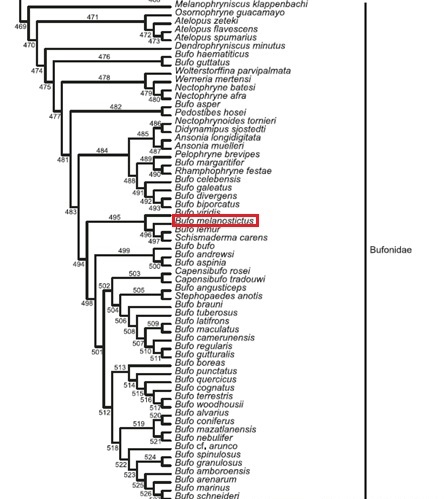
Figure 18. Phylogenetic relationship of the Asian Common Toad (listed as Bufo melanostictus in this tree) in the family Bufonidae. A general phylogenetic tree constructed from the consensus of four most parsimonious trees. (Source: Frost, et.,al., 2006. Copyright from the American Museum National History 2006.)
Other sequences like 12S rRNA and 16S rRNA are also often used to construct phylogenetic trees like the ones in Figure 19. Studies have shown that both the Asian Common Toad from West Bengal in India and in China are very closely related despite being separated geographically by the Himalayas for a considerable amount of time [24].
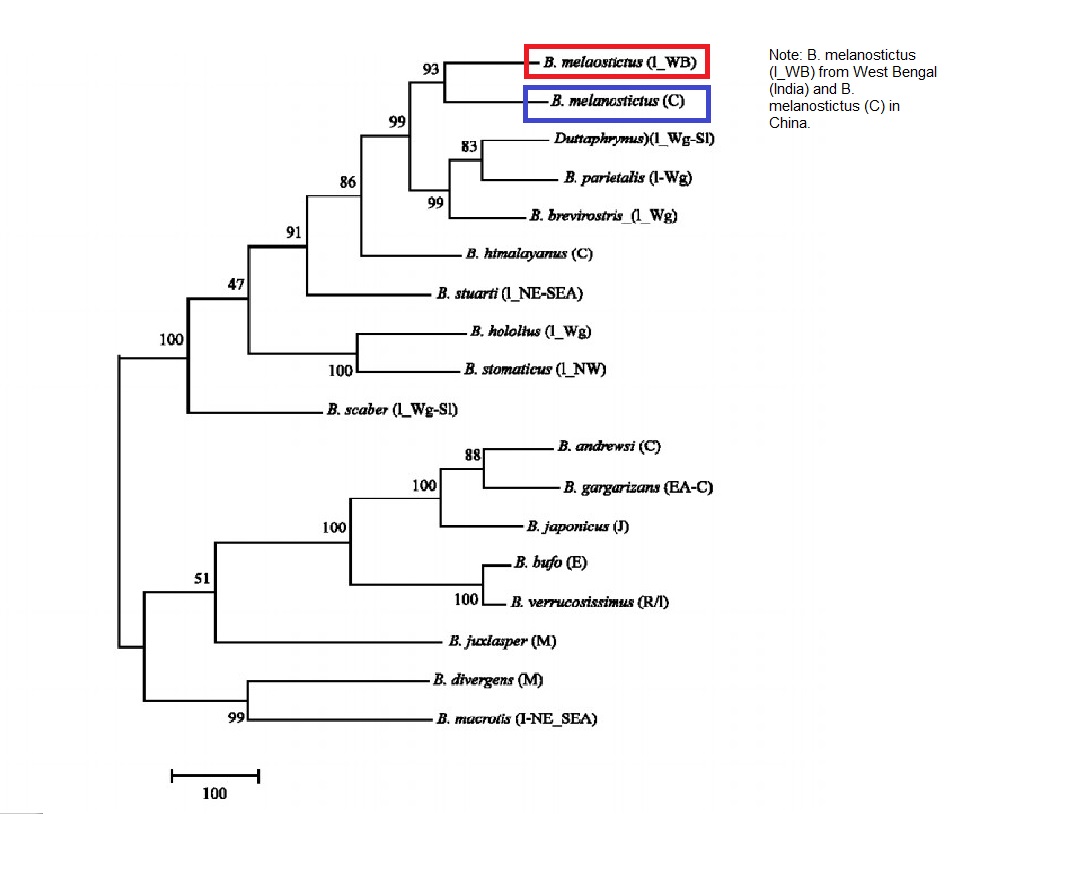
10. GLOSSARY
- Generalist - Species that are able to thrive in a wide variety of environmental conditions and can make use of a variety of different resources.
- Bufotoxin - Moderately potent poison secreted in the skin of many anuran amphibians, especially in the typical toads (genus Bufo)
- Plasticity - Adaptability of an organism to changes in its environment or differences between its various habitats.
- Predation risk - The effect of the absence or presence of predators that feed on its prey
- Opportunistic feeding - Species that are able to sustain itself on different food sources
- Spermatogenic cycle - Process of the production of sperms; the male reproductive cell.
- Amplexus - A type of mating behavior in which males grasps a female with his front legs during which the male fertilizes the female eggs as they are released from the body
- Polygynandry - Reproductive strategy that occurs when two or more males have an exclusive sexual relationship with two or more females.
- Metamorphosis - biological process by which an animal physically develops after birth or hatching, involving a conspicuous and relatively abrupt change in the animal's body structure through cell growth and differentiation.
- Holotype - single physical example (or illustration) of an organism, known to have been used when the species (or lower-ranked taxon) was formally described.
- Maximum parsimony tree - has an optimality criterion whereby the phylogenetic tree that minimizes the total number of character-state changes is chosen.
11. USEFUL LINKS
- Nick Baker's page on Amphibians of South-east Asia - This website highlights some of the common amphibians found in Southeast Asia according to their family. Take a look at the true toads under the family Bufonidae to find the Asian Common Toad!
- Wild Singapore's page on Amphibians in Singapore: A blog on Singapore's Wildlife. - This website showcases the frogs and toads commonly found here in Singapore, including the Asian Common Toad which is listed as 'Asian Toad' in this website.
- IUCN Red List - Duttaphrynus melanostictus - The IUCN provides an interesting evaluation regarding the Asian Common Toad to assess its conservation status.
12. REFERENCES
- Church, G. (1960). The invasion of Bali by Bufo melanostictus. Herpetologica, 16(1), 15-21.
- Frost D, Grant T, Faivovich J, Bain R, Haas A,Haddad C, de Sá R, Channing A, Wilkinson M,Donnellan S, Raxworthy C, Campbell J, Blotto B, Moler P, Drewes R, Nussbaum R, Lynch J,Green D, Wheeler W. (2006). The amphibian tree of life. Bulletin of the American Museum of Natural History. 297: 1–370.
- Khan, M.S. (1991). Unpublished Ph.D. dissertation, University of the Punjab, Lahore, Pakistan.
- Alexander, G. (1933). Secondary Sexual Characters of Bufo melanostictus Schneider. Copeia, 1933(4), 204–207.
- Krysko, K.L. and 12 others. 2011. Verified non-indigenous amphibians and reptiles in Florida from 1863 through 2010: Outlining the invasion process and identifying invasion pathways and stages. Zootaxa 3028:1-64.
- Paul van Dijk, P., Djoko Iskandar, Wai, M. N. L., Gu, H. Geng, B., Lue K., Chou, W, Yuan, Z. Bosco, C., Dutta, S., Inger, R., Manamendra-Arachchi, K.,Khan, M.S. (2004). Duttaphrynus melanostictus. In: IUCN 2014
- Berry, P. Y. (1964). The breeding patterns of seven species of Singapore Anura. The Journal of Animal Ecology, 227-243.
- Dutta, D., & Das, S. K. (2013). Phylogenetic Relationship of Duttaphrynus melanostictus From India and China as Revealed from the Study of 12S and 16S mtDNA Genes. International Journal of Zoological Research, 9(2), 49.
- Khan, M.S. (1982a). ''Collection, preservation and identification of amphibian eggs from the plains of Pakistan.'' Pakistan Journal of Zoology, 14, 241-243
- Mercy, M. 1999. Studies on some aspects of the Biology and Ecology of the Common Indian Toad Bufo melanostictus Schneider (Class Amphibia; Order Anura). Mahatma Gandhi University Online Theses Library.
- The State of Queensland, Department of Employment, Economic Development and Innovation. (2010). Pest Risk Assessment: Asian spined toad (Bufo melanostictus). PR10_5469. Queensland, Australia: The State of Queensland. Accessed Nov 02, 2015 at http://www.daff.qld.gov.au/documents/Biosecurity_EnvironmentalPests/IPA-Asian-Toad-Risk-Assessment.pdf.
- Luniak, M. (2004). Synurbization–adaptation of animal wildlife to urban development. In Proc. 4th Int. Symposium Urban Wildl. Conserv. Tucson (pp. 50-55).
- Bickford, D., Ng, T. H., Qie, L., Kudavidanage, E. P., & Bradshaw, C. J. (2010). Forest fragment and breeding habitat characteristics explain frog diversity and abundance in Singapore. Biotropica, 42(1), 119-125.
- Inger, R. F. & Stuebing, R. F. (2005). A field guide to the frogs of Borneo. 2nd edition. Natural History Publication, Kota Kinabalu.
- Berry, P. Y. & Bullock, J. A.. (1962). The Food of the Common Malayan Toad, Bufo melanostictus Schneider. Copeia, 1962(4), 736–741.
- Bartlett, R.D. & Griswold, B. (2001) Reptiles, amphibians, and invertebrates: an identification and care guide. Barron’s Educational Series.
- Daniels, RJR (2005) Amphibians of peninsular India. Universities Press (India).
- Huang, W. S., Cheng, Y. S., & Tu, H. Y. (2004). Reproductive patterns of two sympatric ranid frogs, Rana latouchii and R. sauteri, with comments on anuran breeding seasons in Taiwan. Coll. Res, 17, 1-10
- Saidapur, S. & Girish, S. (2001). Growth and Metamorphosis of Bufo melanostictus Tadpoles: Effects of Kinship and Density. Journal of Herpetology. 35 (2): 249- 254.
- Khan, M.S. (1982b). ''Collection, preservation and identification of amphibian eggs from the plains of Pakistan.'' Pakistan Journal of Zoology, 14, 241-243
- Mogali, S. M., Saidapur, S. K., & Shanbhag, B. A. (2011). Levels of predation modulate antipredator defense behavior and metamorphic traits in the toad Bufo melanostictus. Journal of Herpetology, 45(4), 428-431.
- Schneider, J. G. (1799). Historia Amphibiorum Naturalis et Literarariae. Fasciculus Primus. Continens Ranas, Calamitas, Bufones, Salamandras et Hydros in Genera et Species Descriptos Notisque suis Distinctos. Jena: Friederici Frommanni. 216
- Che, J., Chen, H.M., Yang, J.X., Jin, J.Q., Jiang, K., Yuan, Z.Y., Murphy, R. W. and Zhang, Y.P. (2012), Universal COI primers for DNA barcoding amphibians. Molecular Ecology Resources, 12: 247–258. doi: 10.1111/j.1755-0998.2011.03090.x
- Dutta, D., & Das, S. K. (2013). Phylogenetic Relationship of Duttaphrynus melanostictus From India and China as Revealed from the Study of 12S and 16S mtDNA Genes. International Journal of Zoological Research, 9(2), 49.
- Shine, R. (2010). The ecological impact of invasive cane toads (Bufo marinus) in Australia. The Quarterly Review of Biology. 85(3), 253-291.